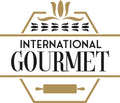Gluten-free foods provide many health benefits, especially for those diagnosed with celiac disease or gluten intolerance. A gluten-free diet has been linked to improved physical health, weight loss, and increased energy levels. Gluten-free foods also help ease digestive symptoms like bloating, reduce joint pain, and improve bone and skin health, among other benefits. But following a gluten-free diet can be hard. It is a major lifestyle modification and can feel daunting/frustrating, considering many foods contain gluten. All wheat contains gluten, including spelt, farro, and durum. This means that food made from wheat, like bread and pasta, is off-limits. Other grains and foods that usually contain gluten include barley, rye, crackers, baked goods, breakfast cereal, certain condiments and sauces, and many more.
How do you find gluten-free foods? To help you, we'll be sharing what you need to get started on healthy gluten-free eating. International Gourmet uses sustainably sourced, clean-eating ingredients to make gluten-free snacks and baked goods. They have chocolate chip tea cookies, superfood grain-free granola with functional mushrooms, and butter pecan tea cookies.
How to start a gluten-free diet
-
Learn what foods to avoid and what to include
When starting your gluten-free meal plan, the first step is to know what foods to avoid. This includes foods that contain wheat, barley, and rye. You should also avoid processed foods as the chances of cross-contamination in factories are high. After crossing out all the gluten options, start looking into common gluten-free meals.
There are various naturally gluten-free grains and flours, such as rice, potatoes, beans, sorghum, quinoa, millet, buckwheat, cassava, coconut, arrowroot, chia, bean flour, and nut flours.
-
Read food labels before buying.
Gluten is lurking in many foods, especially processed foods. When shopping for a gluten-free diet, it is important to carefully read the labels and check if the product bears the gluten-free claim.
For products that are not certified or are labeled gluten-free, it is essential to read the ingredient list.
-
Explore
To avoid having the same meal, explore gluten-free foods online and offline. You can also look at gluten-free alternatives to eat in place of gluten-contain foods like gluten-free cookies, bread, and pasta.
There are chocolate chip tea cookies made with gluten-free grains. However, as you explore, it is important to understand what gluten is, foods containing gluten, and ingredients that can replace the structural-setting functionality that wheat provides in baked goods.
-
Create a list of go-to resources for gluten-free friendly food
With today’s busy lifestyle, it is sometimes hard to prepare meals every day. There are days you just want a takeout meal. To ensure you stick to a gluten-free diet, create a list of go-to resources for gluten-free food. It can include grocery stores, brands, or restaurants.
-
Keep it simple
Getting on any diet, including gluten-free, is hard at first as you are not familiar with your choices and the body is also not used to the change. When creating your gluten-free meal plan, you can start with easy recipes and add fancy recipes to the list as you learn. The most important thing is to ensure that you include proteins, fat, and carb sources with each meal.
To make your journey easier, you can also join gluten-free communities. The communities will help you learn about new gluten-free places and recipes and share other valuable tips. And for delicious healthy snacks, check out our selection at International Gourmet.

